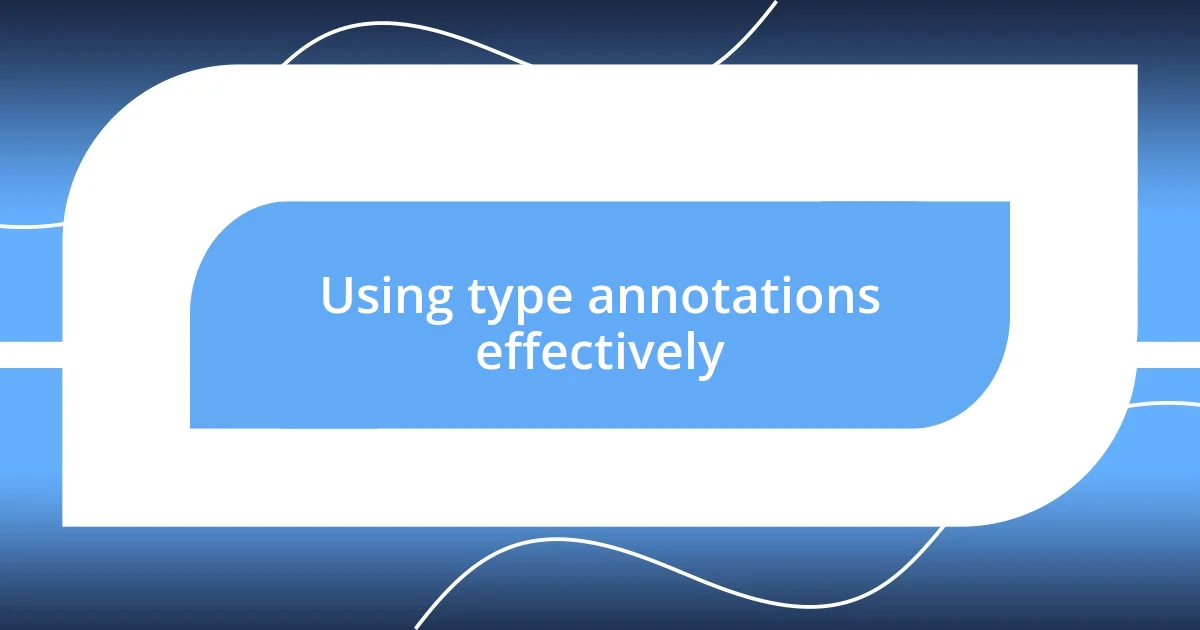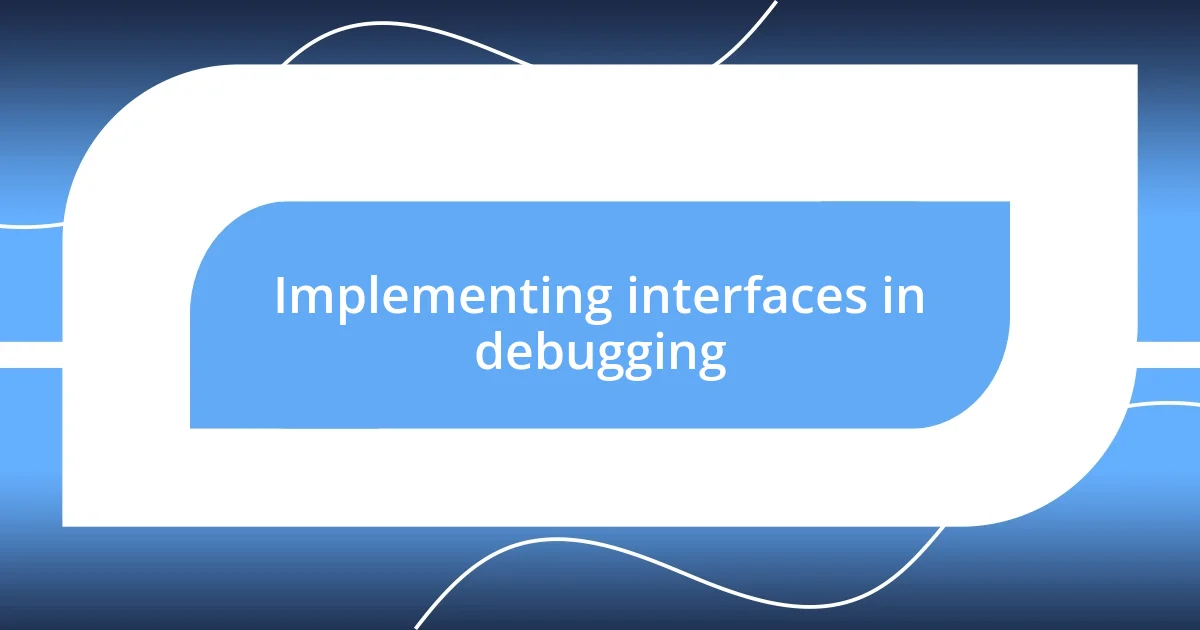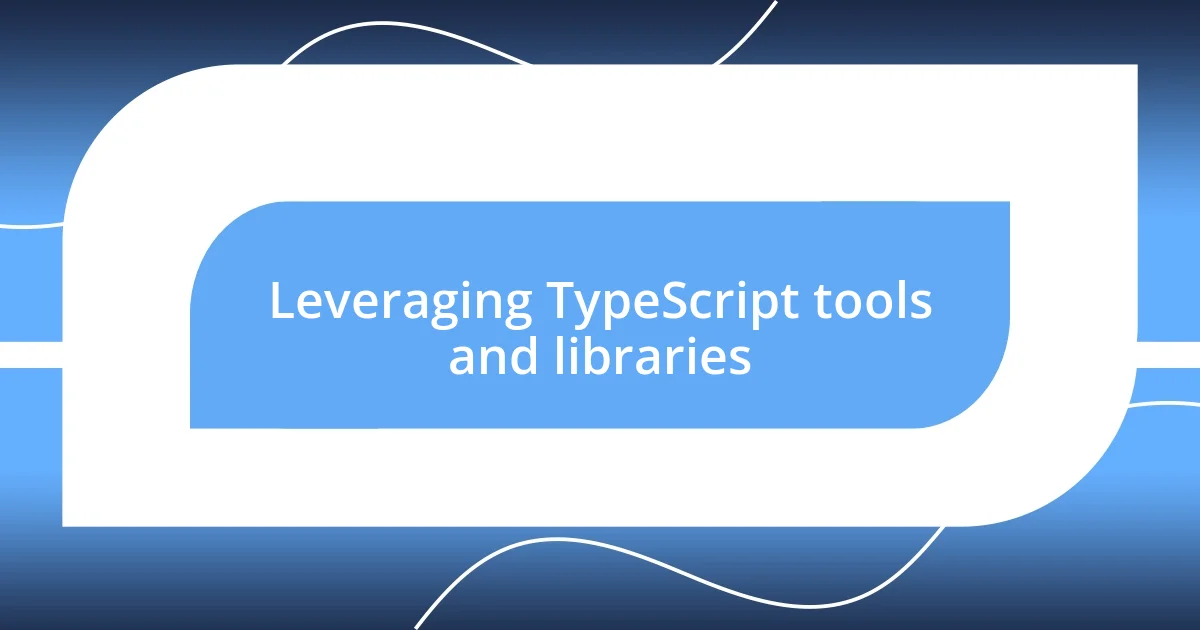Key takeaways:
- TypeScript’s static typing and error reporting significantly reduce debugging time and enhance code quality by catching mistakes early.
- Using features like interfaces and type annotations improves code organization and collaboration, making debugging more efficient.
- Employing tools and libraries, along with maintaining consistent coding styles and taking breaks, can greatly enhance the debugging process and overall coding experience.

Understanding TypeScript features
TypeScript offers a range of features that transform how I approach coding. One standout element is its static typing, which allows me to catch errors at compile time rather than waiting until runtime. I still remember a project where I spent hours debugging a misrouted function, wishing I had used TypeScript to pinpoint the issue sooner.
Another feature I appreciate is TypeScript’s advanced tooling support. The autocompletion and inline documentation have been game-changers for me. I often find myself asking, “How did I manage without this?” The clarity it brings not only boosts my productivity but also enhances my confidence when navigating complex codebases.
Furthermore, TypeScript’s interfaces and generics empower me to create robust, reusable code components. I recall the satisfaction of refactoring an intricate module into smaller, manageable pieces, which was possible solely because of TypeScript’s powerful type definitions. Isn’t it amazing how such features can elevate our coding practices and ultimately lead to better software?

Benefits of TypeScript for debugging
TypeScript significantly enhances my debugging process by providing clear visibility into the types of each variable. Recently, I was working on a project where I encountered a perplexing issue with data structures. Thanks to TypeScript’s type annotations, I quickly identified that a variable was being used inconsistently, allowing me to resolve the bug in minutes instead of hours. That experience solidified my appreciation for TypeScript’s strong typing system, which feels like having a trusted friend guiding me through my code.
Another compelling advantage is TypeScript’s error reporting capabilities. I can’t count the times I’ve been delighted by how TypeScript points out mistakes before I even run the code. In one instance, I mistakenly tried to assign a string to a number type. TypeScript caught that error instantly and directed me to the exact line—no more searching endlessly for that pesky bug. This efficiency not only saves time but also reduces frustration, giving me peace of mind as I develop.
Lastly, TypeScript’s integration with modern IDEs enhances my debugging experience even further. I remember grappling with a complex loop in an old JavaScript project, where finding the right issue felt like hunting for a needle in a haystack. With TypeScript, leveraging the debugging tools and features like breakpoints became incredibly intuitive, allowing me to inspect variables in real-time and understand their flow. It’s this type of interaction that makes debugging not just easier, but also genuinely enjoyable.
| Feature | Benefit for Debugging |
|---|---|
| Static Typing | Catches errors at compile time |
| Error Reporting | Points out mistakes instantly |
| IDEs Integration | Enhances real-time debugging capabilities |

Error catching in TypeScript
Error catching in TypeScript has been a revelation for me. The moment I embraced its error handling system, everything changed. I can still vividly recall a time when I wrote a complicated function only to have it throw errors at every turn. When I dived into TypeScript, I realized that the language’s error catching mechanism allowed me to anticipate issues rather than react to them—like having a safety net beneath my work. It’s less about finding a lifeboat when I’m already sinking, and more about ensuring I never capsized in the first place!
One of the most impressive features is how TypeScript handles unexpected values. Here’s what I’ve noticed:
- Type Guards: They help me narrow down the possible types of a variable, making it easy to handle different cases without crashing my application.
- Try-Catch Blocks: These allow me to manage expected errors efficiently. I can capture and address specific errors without bringing my code to a halt.
- Compile-Time Errors: The satisfaction I feel when TypeScript flags potential issues before I hit ‘run’ is unmatched. It feels like an intuitive partner, always looking out for my best interests.
This proactive error catching has transformed my coding journey, turning potential chaos into controlled clarity. It’s empowering to know that I can write with confidence, knowing TypeScript is diligently watching my back.

Using type annotations effectively
Using type annotations effectively can significantly change your coding experience. I remember a time when I was wrestling with a complex function related to user input. By specifying type annotations earlier in the process, I could avoid a slew of errors that would emerge during runtime. It felt like shedding the weight of uncertainty— I could see at a glance what each variable was supposed to be, which made debugging so much clearer and more focused.
In practice, type annotations serve as a sort of contract between my code and me. For instance, when I declared a variable as a number but accidentally tried to assign it a string, TypeScript flagged the mismatch immediately. I can’t stress enough how comforting it is to have that level of checking in place. It’s as if TypeScript turns a daunting debugging session into an engaging puzzle, where the pieces start fitting together more seamlessly.
Moreover, type annotations help with documentation in a way that improves collaboration with other developers. There was a project where several of us were working on shared components, and I found it invaluable to have clear type definitions. It minimized miscommunication, and everyone understood the expected data structures quickly. This efficiency reminded me of the importance of clarity in teamwork. Have you ever worked on a project where misunderstood data types led to chaos? Using type annotations can often prevent that type of confusion before it even starts.

Implementing interfaces in debugging
One of the most powerful aspects of implementing interfaces in my debugging process is how they create a clear blueprint for my objects. I remember building a feature that required multiple objects adhering to specific structures. By defining an interface for those objects, it was incredible to see how TypeScript flagged discrepancies right away. This immediate feedback felt like having a personal coach, pointing out where I needed to step up my game.
When I encountered a mismatch between expected and actual properties, it was frustrating at first. But now, with interfaces, I feel a sense of relief. I can pinpoint the exact property that doesn’t align with my interface, making it easier to address the issue without digging through tons of code. Have you ever spent hours tracking down a bug, only to realize it stemmed from a simple typo? Interfaces help me avoid those gut-wrenching moments by enforcing a level of consistency that keeps my code more organized.
Additionally, the beauty of interfaces lies in their reusability. There was a project where I needed similar data structures for different components. Thanks to interfaces, I could redefine what each component required while maintaining a solid foundation. This not only streamlined my debugging but also sparked joy in finding efficient solutions. Have you experienced the satisfaction of seeing your code become cleaner because of smart structuring? Implementing interfaces truly enhances the debugging process, transforming it from a reactive scramble into a proactive strategy.

Leveraging TypeScript tools and libraries
Leveraging TypeScript tools and libraries can greatly enhance the debugging journey. For instance, I’ve found that using libraries like TSLint has been a game-changer. The linter catches potential issues right in the editor, allowing me to resolve them before they escalate into runtime errors. It’s like having a supportive friend standing next to me, whispering warnings about pitfalls to avoid. Wouldn’t it be great if every coding session could be that smooth?
Another tool that I swear by is the TypeScript Language Server. It offers features like autocompletion and inline documentation, making the code-writing process much more intuitive. I vividly remember a time when I was exploring a new API, and instead of flipping through documentation, the language server provided me with information in real-time. This not only improved my efficiency but also reduced the mental strain of keeping track of multiple contexts. Have you ever had a moment where the right tool just clicked? That’s exactly how I feel when using these powerful resources.
Finally, I can’t overlook the benefits of using frameworks that are built with TypeScript in mind, like Angular. They come with built-in typing, which simplifies the debugging process significantly. I once worked on a sizeable Angular application, and the type safety helped catch errors early, which felt like finding hidden treasures in my codebase. I was able to focus more on building features rather than constantly worrying about underlying issues. Isn’t it fascinating how the right frameworks can elevate a coding experience?

Best practices for improved debugging
When it comes to improving debugging practices, I’ve found that maintaining consistent coding styles is crucial. I remember a project where inconsistency in variable naming led to endless confusion. By adopting tools like Prettier for code formatting, I started seeing how a uniform structure could make spotting issues much easier. Have you ever noticed how clarity in coding can dramatically change your debugging experience?
Equally important is the practice of writing concise, meaningful comments. I often jot down notes about why a particular piece of code exists. There was a time I faced an elusive bug, only to realize I’d forgotten some important logic tucked away in a comment. That experience taught me the value of articulating my thoughts; after all, my future self deserves a helpful guide too! Have you ever wished you could have a conversation with your past self during a chaotic debugging session?
Lastly, I can’t stress enough the importance of taking regular breaks during intensive debugging. It might sound counterintuitive, but stepping away has repeatedly helped me see problems from a fresh perspective. I recall a particularly long day spent chasing down a stubborn bug. After I decided to take a walk, the solution suddenly popped into my head as I was relaxing. Isn’t it amazing how sometimes your best ideas come during the most unexpected moments?














